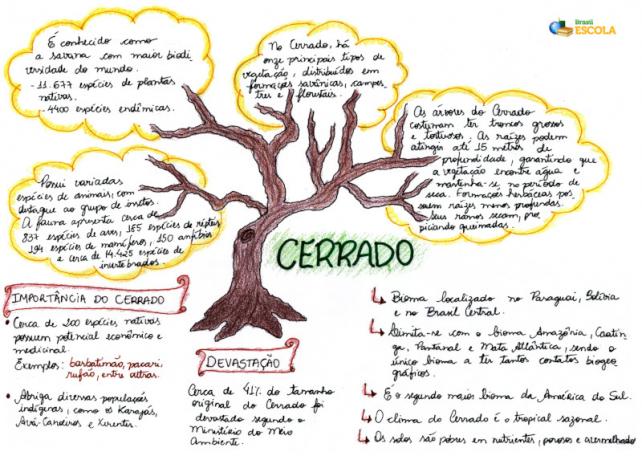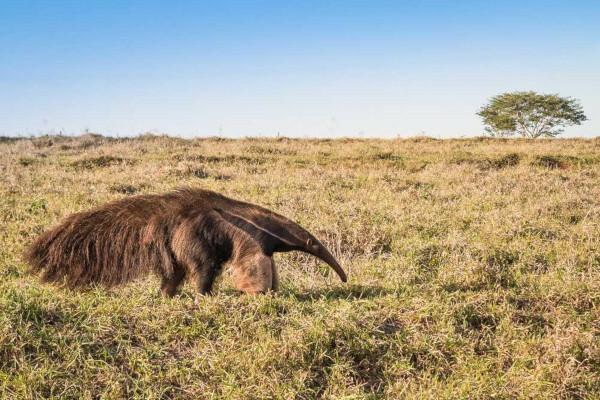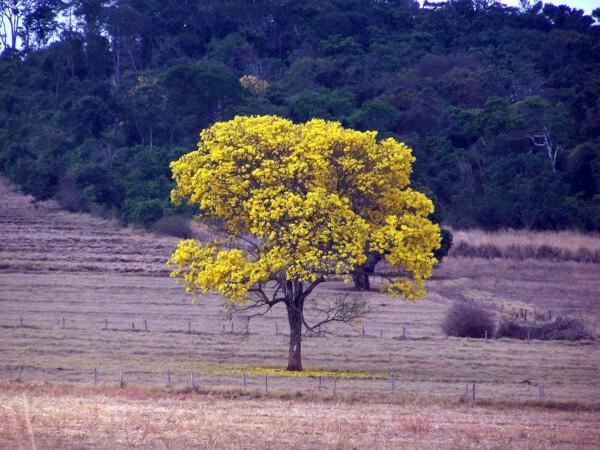O thick it is the second largest biome in South America and the second largest biome in Brazil, comprising about 22% of the Brazilian territory. It is characterized by being a savanna region, extending over about 200 million square kilometers. It has a plant formation of great biodiversity and great aquifer potential, however, it is currently considered the second most threatened biome in Brazil.
Read too:What are the main biomes in the world?
Characteristics of the Cerrado
→ Location

The Cerrado biome is located in Central Brazil, comprising ten Brazilian states. (Source: IBGE)
O thick is a biome located in northeastern Paraguay, eastern Bolivia and much of Central Brazil, constituting about 22% of the Brazilian territory. In Brazil, its area comprises the states of Goiás, Mato Grosso, Mato Grosso do Sul, Tocantins, Minas Gerais, Bahia, Maranhão, Piauí, Rondônia, Paraná, São Paulo and Distrito Federal and some enclaves (land or territory within another) in Amapá, Amazonas and Roraima. It is estimated that the area covered by the Cerrado in Brazil, according to the IBGE, reaches 2,036,448 km
2 of extension.The Cerrado biome is limited to the north by the Amazon biome; to the east and northeast, with the Caatinga; to the southwest, with the wetland; and to the southeast, with the Atlantic Forest. This gives the Cerrado biome a unique feature: it is the only biome in South America to have so many biogeographic contacts. The region encompassed by this plant formation has altitudes ranging from 0 to 1800 meters. This area covers different hydrographic basins, such as the Amazon Basin, Tocantins Basin, Paraná Basin, São Francisco Basin and Parnaíba Basin.
Know more: Brazilian hydrographic basins
Mind Map: Cerrado

*To download the mind map in PDF, Click here!
→ Cerrado vegetation and flora

The Cerrado vegetation is characterized by trees with crooked trunks, shrubs and grasses.
The Cerrado is recognized as the savanna with the greatest biodiversity in the world, sheltering about 11,627 species of native plants, with approximately 4,400 endemic species (existing only in this biome). Due to its extension, the Cerrado biome does not have a unique phytophysiognomy (aspect of vegetation in a region). The vegetation is quite diverse, ranging from rural forms, such as the clean fields, to dense forest formations, such as the thickets. The factors that enable this variety of physiognomies are related to the types of soil, types of climate and types of relief in the regions that shelter the Cerrado.
In the Cerrado, there are eleven main types of vegetation, which are distributed in savanna, forest and countryside formations. These phytophysiognomies have a wide variety of species, with arboreal, herbaceous, shrub and vine plants. This variety of vegetation can be distributed into two strata:
woody layer: composed of long trees and shrubs;
herbaceous stratum: composed of herbs and sub-shrubs.
These strata have different characteristics, which makes them competitive, as they depend on specific conditions to develop, that is, what benefits one of the strata ends up harming the other. Herbaceous formation, for example, is characterized by the absence of shade. Therefore, if there is a densification of the woody formation, the herbaceous formation will face problems to develop, because the shading does not favor its growth.
The woody strata trees that make up the Cerrado usually present thick and crooked trunks. Its roots can reach up to 15 meters in depth, ensuring that the vegetation finds water and is able to maintain itself regardless of the drought. Herbaceous formations, on the other hand, have shallower roots, reaching approximately 30 centimeters in depth. Because of the shallowness, the branches of herbaceous formations dry out as the dry season sets in. These dry branches provide the burned recurrent in this type of biome.
Due to the plant diversification of this biome, there are trees that reach up to 20 meters in height, as well as cacti and orchids (these are found in plateau areas). This diversity guarantees the Cerrado some shades in its landscape. The main colors found in this biome are green, yellow and brownish tones due to the discoloration of the vegetation caused by the strong incidence of the sun.
The following vegetation species stand out in the Cerrado:
angelic |
barbatimão |
mastic |
ipe |
copaiba |
canjerana |
kingwood |
peki |
groundwood |
alligator stick |
wolf |
necktie |
inga |
little mosquito |
jabuticaba |
→ Cerrado climate
The Cerrado biome is predominantly constituted by the climate tropical seasonal, characterized by dry winters and rainy summers, with an average rainfall of 1,500 mm. This precipitation varies within limits with other biomes. In the Cerrado region bordering the Caatinga, for example, the rainfall index is between 600 mm and 800 mm. At the limit with the Amazon biome, precipitation ranges from 2,000 mm to 2,200 mm.
THE season defined by the dry period usually starts in the month of May, ending in the month of September. A andrainy season starts in October, extending to the month of April. At this station, it is common to have calls summery people, which are short periods of drought. The average annual temperature is around 22º C, the averages varying throughout the seasons. During dry periods, air humidity can reach 15%, usually in July and August. THE insolation it is quite intense and is reduced during rainy periods due to the high cloudiness.
→ Cerrado fauna

The giant anteater is a common animal species in the Cerrado.
The Cerrado has a wide variety of animal species, highlighting the insect group. Despite the wide variety, the Cerrado fauna is little known, especially the invertebrate group. The fauna has about 837 species of birds, 29 of which are endemic; 185 species of reptiles, of which 24 are endemic; 194 species of mammals, 19 of which are endemic; and 150 amphibians, 45 of which are endemic. Some studies indicate that there are about 14,425 invertebrate species.
The main examples of vertebrate animals from the Cerrado are:

→ Cerrado soil
The soils of the Cerrado biome are characterized by their depth, drainage and for being old, dating back to the Tertiary Period. Soils generally have a reddish color, are porous and permeable, therefore, they undergo intense processes of leaching (washing of the topsoil by surface water runoff). However, there are regions of the Cerrado where the soils have armor formations, which end up making entry difficult. rainwater, preventing the formation of lush vegetation in these areas and the development of agriculture.
Do not stop now... There's more after the advertising ;)
Read too:Types of soil in the Cerrado
The texture of the soils in this biome is diversified, with a predominance of sand, Followed by clay and silt. So it can be said that the soils are predominantly sandy or clayey, which results in low water holding capacity. With regard to chemical characteristics, Cerrado soils are highly acidic, with a pH that varies between 4 and 5 (neutral pH is 7). The acidity given to these soils is due to the fact that they present high levels of aluminum in their composition.
In this biome, the oxisols, characterized by excessive acidity, and the podzolics, which can also be called argisols. Oxisols have a reddish color and are poor in nutrients. already the podzolics they are darker in color, with red tones, and are quite susceptible to erosive processes. The lack of nutrients in some soils in this biome hindered the development of agriculture. This has been fixed with techniques such as liming, able to correct soil acidity.
Main agricultural products grown in the Cerrado:
" Soy;
" Sugar cane;
" Corn;
" Cotton.
Read too:How does soil leach occur?
What are the “types of Cerrado”?
The use of the expression “types of Cerrado” is not correct. It is known that the Cerrado biome, due to its large extension in the Brazilian territory and for bordering several other biomes, has varied landscapes and a great biodiversity. The correct term to refer to these landscape variations is phytophysiognomiesof the Cerrado. These phytophysiognomies vary according to regions, climate, soil and relief characteristics. The most common classification has the following types of phytophysiognomy:
1. Clear Fields: is a type of vegetation composed of grasses, without the presence of woody strata. This type of phytophysiognomy is suitable for the movement of animals such as the jaguar, rhea and giant anteater.
2. Dirty Field: is commonly known as thin savanna and it consists of plants from the herbaceous stratum, in which shrubs are not very expressive.
3. Cerrado Ssense tricto: represents the most predominant vegetation in this biome. It consists mainly of shrub species, composed of small trees with tortuous and thick trunks. These shrubs are not dense, as in areas of dense forests, and they adapt to the conditions of the environment, having very deep roots, which reach the groundwater.
4. Dry Forest: this type of phytophysiognomy is far from water courses. It is home to trees such as ipê and aroeira, which during the dry season lose their leaves due to the low availability of water.

Ipê is a characteristic tree of the phytophysiognomy known as dry forest.
5. Cerradão: constitutes a transitional vegetation between the dry forest and the cerrado strictu sense. It presents trees with many leaves and branches, in addition to crooked features. In this phytophysiognomic type, there is a vegetation larger than the shrubs, reaching nine meters in height.
6. Galleries Woods: also known as Humid Forests, are vegetation that accompany the water courses. They have trees that can reach up to 30 meters in height, smooth trunks and small leaves. They keep their foliage green all year round thanks to the presence of water.
7. paths: also known as Várzeas Areas, they are located in spring areas of several hydrographic basins. The vegetation is commonly formed by buriti and forest and field species. They are limited to clean fields and dirty fields. The vegetation is exuberant.
8. rupestrian savanna: this type of vegetation is formed in environments with rocky characteristics, especially in mountain ranges. The main species of this type of physiognomy are cashew, papyrus, murici and mangaba.
Importance of the Cerrado
The Cerrado is a biome that, due to its great biodiversity, must be conserved. Studies show that about 200 native species of this biome have, in addition to economic potential, medicinal potential. Some plant species have already been patented by pharmaceutical industries. Examples of Cerrado species with medicinal potential according to the Ministry of the Environment:
barbatimão: is a Cerrado tree whose bark, leaves and roots can be used to heal wounds, ulcers and bleeding;
pacari: is a Cerrado tree whose leaves and bark can be used for healing, treatment of ulcers and gastritis;
ruffian: it is a plant from the Cerrado that grows among bushes whose roots can be used to make teas or bottles. The ruffian root is used to treat anemia and inflammation in the stomach and intestine.
Another relevance of this biome is that it comprises an area inhabited for hundreds of years, mainly indigenous populations. It is from the biome that these peoples make their living, extracting natural resources from it, therefore it is necessary that this biome is preserved so that these communities can maintain their survival. The main indigenous communities existing in the Cerrado are Karajás, Avá-Canoeiros and Xerentes.
Cerrado devastation
The loss of biodiversity in the Cerrado biome is already a reality. It took only five decades to reduce the original size of this biome to 41% of the original total, according to the Ministry of the Environment. The main activities that compromise the conservation of this biome are related to the extractivism and the agricultural expansion. Expanding agricultural activity requires deforesting areas, which is happening frequently in the region covered by the Cerrado.
THE livestock it has also caused numerous impacts on the biome, as deforestation to create pasture areas is intense. These activities, in addition to mischaracterizing the biome in the landscape sense, also alter the maintenance of biodiversity, as many animals lose their habitat, running the risk of becoming extinct, as well as endemic species of plants.
It is worth remembering that the thick it encompasses a large area of hydrographic basins, having an immense aquifer potential, representing 8% of water availability at the national level. When areas are deforested to make activities such as agriculture viable, in addition to degrading nature, it also provides siltation of basin areas and can cause water contamination due to the use of pesticides in production agricultural.
Summary
The Cerrado is considered the second largest biome in South America and the second largest biome in Brazil. It is known as the Brazilian savanna and has a great biodiversity. Its vegetation has predominant characteristics, such as trees with a thick and crooked trunk, as well as grasses and shrubs. The Cerrado's climate is tropical seasonal, with two defined seasons: a dry and a rainy one. The soils of this biome are generally poor in nutrients, have a reddish color and high porosity. The fauna of the Cerrado, although little known, is quite diverse, with species such as the jaguar and the giant anteater. Unfortunately, the Cerrado is a plant formation that has been heavily devastated, mainly due to the expansion of agricultural activities, which has caused countless losses of biodiversity.
by Rafaela Sousa
Graduated in Geography


